Adoption Lessons in Black & White
Stephanie Poole embraces her children – from left, Nyara, Carter and Maya – at their home in Seattle, Washington. (Claire Morin-Gibourg/VOA)
November 2019
Every year, American families bring home tens of thousands of children through domestic and foreign adoptions. Bringing home any new child takes adjustment. Bringing home a child of a different race adds another layer of complexity.
During National Adoption Month, VOA is taking a close look at the experiences of black children who are disproportionately represented in the U.S. child welfare system and are often adopted into white families.
What challenges do these parents and kids encounter when forming a transracial family? What do adoptees think about immersion in homes, schools and communities with little racial diversity?
Claire Morin-Gibourg of VOA's Africa Division explores such questions in this multipart series.
Part I: Challenges ‘We do see color’
Deborah Hill admires daughter Lizelle’s twists, done at the Neema Hanifa salon in Albuquerque, New Mexico. (Arzouma Kompaoré/VOA)
ALBUQUERQUE, New Mexico — For more than 20 years, Megan Walsh has helped families welcome adopted children into their homes. She has found that the challenges increase when a parent and child differ in race.
‘At 10, he's just starting to notice that people might be looking at us, that we don't look like every other family in town, that there aren't as many black children in our neighborhood."’
– Erika Tode, about son Jayden
"A lot of adoptive families struggle when they adopt transracially because they are maybe not so comfortable stepping outside their comfort zone," Walsh said, stressing that parents must recognize "they're asking their child to often be the minority" in their families and beyond.
Walsh was the longtime director of La Familia-Namaste, an adoption agency in this capital city in the southwestern United States. La Familia finds families for roughly 80 children a year. A third of its placements are transracial. Walsh moved back to her native Washington state last year, and now works as a behavioral health specialist at a pediatric therapy clinic.
In Albuquerque, she helped the Hill family, whose South African-born daughter, Lizelle, now 16, knows what it feels like to be "other."
"Sometimes, I'll walk into a class, and the first thing that comes to mind is, 'Is there another black person in this room that I could relate to, that looks similar to me?'" she said.

Megan Walsh leads a workshop to help adoptive families meet the needs of youngsters with attention deficit disorder. (Claire Morin-Gibourg/VOA)
Lizelle's parents are white, and mindful, as Walsh has counseled, of respecting a child's differences while nurturing a sense of belonging.
That understanding brought Lizelle and her mother, Deborah Hill, to Kamaria Creations, a hair and skin salon specializing in treatments for African Americans.
"With most [transracial] families, what I found is that they start by coming in and asking about hair. That's the initial referral — 'I need to know about how to take care of this child's hair!'" said Neema Hanifa, the salon's owner.
"It's so much deeper than that," Hanifa added. "Self-esteem, of course. How a child feels being in a place like New Mexico, where we have such a small population of African descent."
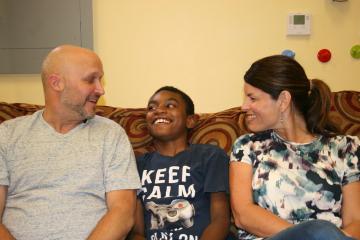
Erika and Steve Tode chat with son Jayden at La Familia-Namaste, an adoption agency in Albuquerque, New Mexico. (Claire Morin-Gibourg/VOA)
Under 3% of New Mexicans identify solely as black or African American, according to Census data.
Hill says that through her daughter — and also through son Levi, adopted after his birth in Albuquerque to parents of Haitian and Kenyan descent — she came to understand that "hair is a sociopolitical issue in our culture." She not only found the salon for her children, but she also has studied blogs, books and YouTube videos on styling and caring for black hair.
"We are very much connected with the black community here and in other places we've lived, including Africa," Hill said in an email. She and her husband, George Schroeder, believe their children should "not grow up in an entirely white context, as this will not be their experience when they launch out onto their own."
Walsh thinks parents involved in transracial adoptions of black children should look for adult racial mirrors for them — black pediatricians, teachers, dentists — especially when they live in predominantly white areas.
"Look for friendships with people (who) are their child's ethnicity, but also friendships of any ethnicity," Walsh said. "Kids need to know that their parents appreciate and value people of other cultures and see them as equals."
She added, "Learning to value everyone of every ethnicity and not be afraid of what we don't know, I think that's what's really important. People that get really stuck on being colorblind, I feel that they're doing their kids a disservice, because they're not teaching them that how they are is wonderful, and how they came into this world is important and vital for everybody."
Families can struggle with transracial adoption because it often forces them to step out of their comfort zone, says Megan Walsh, former director of La Familia-Namaste adoption agency in New Mexico. (Arzouma Kompaoré/VOA)
Part II: Identity ‘This Black Boy Did Not Want to be Black’
Chad Goller-Sojourner, shown as a boy at left, says his adoptive parents, Gayla and Alan Goller, ‘did a lot’ for him, his brother and sister. (Photo courtesy of Goller family)
SEATTLE, Washington — In his performance art, Chad Goller-Sojourner lays out a core disconnect from his childhood.
"I was this black boy who did not want to be black. … Black people scared me," he tells audiences, to some nervous laughter.
Yet over time, he has harnessed that sense of alienation — not only to entertain, but also to engage with the transracial adoptive families he coaches. The goal: help adoptees build a healthy identity as they navigate across color lines.
‘I was this black boy who did not want to be black. … I identified with my white peers, as opposed to black people either I saw on TV or I did not know.’
– Chad Goller-Sojourner, transracial adoption coach
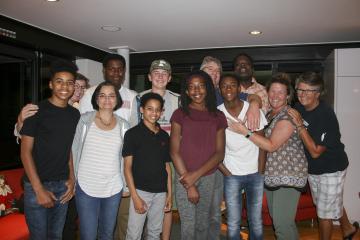
Chad Goller-Sojourner, at upper right, poses with transracial adoptive families that he coaches in Seattle, Wash. (Claire Morin-Gibourg/VOA)
Now in his late 40s, Goller-Sojourner was adopted at 13 months by Alan and Gayla Goller, a white couple in Tacoma, in the northwestern U.S. state of Washington. There, "I was certainly socialized as the white child. There was no blackness around me."
He says his parents "did a lot" to integrate him, as well as his brother, Brett, and sister, Zanna, also of color.
"We moved to Africa for a couple of years. When we were back in the U.S., my parents sent us to a school with more black people, but that does not negate the power of whiteness."
Goller-Sojourner insists that parents in transracial families "have a duty to prepare their child not just for the world they live in but, most importantly, for the world they will age into."
He realized that while he'd also known privilege in the white suburbs as a youth, he might be perceived as threatening in the very same setting as an adult black man.
He explores that theme in one of his solo shows, the autobiographical "Riding in Cars With Black People & Other Newly Dangerous Acts." Another show, "Sitting in Circles With Rich White Girls: Memoirs of a Bulimic Black Boy," explores his efforts to find acceptance.

Goller-Sojourner looks at memorabilia of his biological mother, Yolandia-Maria Hurtt. (Claire Morin-Gibourg/VOA)
To help adoptees adjust, he also urges their parents to build or preserve ties between the child and biological kin.
"A lot of people forget that adoptees have a story before they come to you, even at birth," said Goller-Sojourner, who added to his surname as an adult to underscore his questing nature.
His own backstory unfolded more clearly a few years ago, when he was able to track down a biological maternal aunt. She sent him a scrapbook about his birth mother, Yolandia-Maria Hurtt, an actress who appeared on Broadway, as well as in the Midwestern state of Ohio. She died in 2011.
The scrapbook gives Goller-Sojourner a cherished physical connection to Hurtt.
"This is her work. Her fingerprints are on here. My fingerprints are on here. Although she is deceased, I am touching my mother — not metaphorically, but really. And certainly that is something beyond what I ever thought possible."
Based on his experiences as a black boy adopted by a white family, Chad Goller-Sojourner coaches transracial families to help youngsters in building identity. (Arzouma Kompaoré/VOA)
Part III: Education Learning About Bias at School
Stephanie Poole and daughter Nyara cheer at a football game. (Photo courtesy of Stephanie Poole)
SEATTLE, Washington — Stephanie Poole teaches fourth grade at a suburban public school near here. Since adopting three black children, she has learned some uncomfortable lessons about how race affects perceptions of a student's behavior or academic performance.
As a first-grader, her daughter, Nyara, "would get punished for leaving class" when "kids were calling her out for the color of her skin," Poole said.
‘The lessons I've learned as a white mom and having black kids - how much institutionalized racism is in our school structure is absolutely phenomenal! And I never had to realize that before.’
– Stephanie Poole, adoptive mother of three
Nyara has been diagnosed with attention deficit disorder and trauma-related problems, like her younger brother, Carter, also adopted.
A school district psychologist evaluated Carter when he was a kindergartner and said he had "violent, aggressive, disruptive" tendencies, Poole said.
Poole insisted those labels be removed from her son's specialized education plan, fearing he otherwise would be sucked into "the school-to-prison pipeline. ... How can you list these descriptors—'violent'—for a 6-year-old boy?" she asked.
Some specialists believe adoption and race both can affect students, and how they're perceived.
Nicholas Zill, a research psychologist in Washington, focused on adopted children's school performance in a 2018 report he co-wrote. It found adopted children are more likely to have learning and behavioral issues than other students, perhaps reflecting instability earlier in childhood.
"Adopted children often have behavioral issues in the classroom, and they have some difficulty getting along with other children at a higher rate than biological children," he said.
Children adopted as babies are much less likely to exhibit problems, Zill added.
Regardless of age, Zill says some adopted children face another complication.
"Generally speaking, black children do have a somewhat higher rate of problems within the adoptive population, as well as in the biological population."
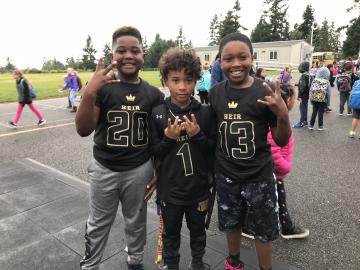
Carter Poole, at right, and his friends flash a ‘half crown,’ the symbol for their football team. Teammates’ connected hands form a full crown. (Photo courtesy of Stephanie Poole)
As a teacher and mother, Poole sees the education system itself as a factor in some children's struggles.
"If you look at the curriculum, it's mostly white," she observes. "If you look at books, they're mostly white. And all of these things [have] disenfranchised our kids of color."
That's no surprise to Constance Lindsay. A University of North Carolina assistant professor of education, she has studied teacher-student demographics.
"If you have a white teacher who isn't trained in cultural competency and how to work with diverse students, it might be harmful for students," she said. "Having a same-race teacher for black students decreases rates of discipline actions" such as suspension or expulsion.
Lindsay co-authored a report in 2017 that tracked students in elementary and high school. It found that those who had at least one black teacher were more likely to aspire to college and less likely to drop out of high school.
Lindsay calls it the role-model effect.
"If you're growing up in a home that doesn't have a college-educated black person, and you're able to see one at school who's your teacher, that might signal to you that, 'Hey, I can do this, too!'" Lindsay said.
Poole says her children have flourished since moving from their Seattle neighborhood school to the suburban Highline Public Schools district where she teaches—and where she says staff are trained to be sensitive to race and equity.
She admits she also needed to be sensitized.
"And even being a teacher. I mean, the lessons I've learned as a white mom and having black kids—how much institutionalized racism is in our school structure is absolutely phenomenal," Poole said. "And I never had to realize that before I had black kids."
Teacher Stephanie Poole says having children of color – including son Carter and daugher Nyara – has opened her eyes to racial bias in education. (Arzouma Kompaoré/VOA)
Part IV: Police Brutality Police Beating Left Him ‘Permanently Altered’
Alex Landau was 19 when he was beaten by police during a traffic stop in Denver, Colorado. His adoptive parents, who are white, now say they were naïve to raise him as if skin color makes no difference. (Claire Morin-Gibourg/VOA)
DENVER, Colorado — College student Alex Landau was driving with a friend to get a late-night burger when police stopped them for an alleged illegal left turn.
Both men were patted down outside the car. When officers wanted to look in the trunk, Landau, 19 and black, stepped forward to ask for a search warrant. In response, he says, the three officers "began to punch me in the face."
‘We didn't understand what it's like to be black in America, what it's like to grow up in a transracial family. … I did not understand about race. I was totally naïve.’
– Patsy Hathaway, white adoptive mother
The 2009 beating left him with a broken nose, 45 stitches, a concussion and traumatic brain injury. It also transformed him—and not just because of a $795,000 police brutality settlement from the city.
"I am a different person because of that night, and it totally changed the trajectory of my life," said Landau, a social justice activist who teaches young people and their parents about civil rights.
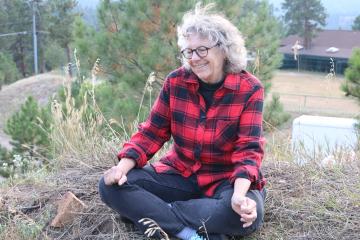
After the anguish of her son’s beating and trauma, Patsy Hathaway has sought solace in nature in Evergreen, Colorado. (Claire Morin-Gibourg/VOA)
His parents, who are white, reflect on what they now consider their naiveté in raising him to believe skin color makes no difference.
Patsy Hathaway and Steve Landau adopted Alex as an infant, and later adopted a baby girl, also black.
"We joined a group for transracial adoptions, and we bought the right kind of books with black characters," Hathaway said. "We didn't care about skin color. When you are Caucasian parents, you may go into it thinking on some levels that you understand the concept of colorblindness. And superficially, we were terrific. But we didn't understand what it's like to be black in America, what it's like to grow up in a transracial family."
Growing up even in predominantly white areas of Colorado, "I never really had the ability to distinguish ... how my skin color was different from other folks around me," Alex acknowledged.
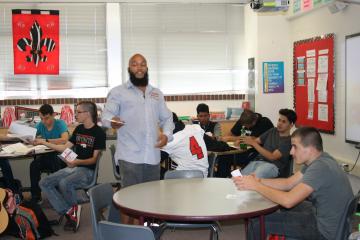
Landau leads a criminal justice workshop for students at Jefferson High School in Edgewater, Colorado. (Claire Morin-Gibourg/VOA)
Now, informed by his own experience and buoyed by the Black Lives Matter movement, he does outreach for the Colorado Criminal Justice Reform Coalition. He leads workshops at high schools and colleges, teaching communities of color about their constitutional rights and protections.
He also goes door to door, as he did one day in Sun Valley, a poor Denver neighborhood where many African immigrants have settled.
"What we are doing out here is we're passing out information on how to navigate interactions with law enforcement," said Alex, whose adoptive paternal grandfather was a police officer.
Patsy and Steve wonder if they could have done more to protect their son from racial bias. Alex contends he would have faced the same risks, even if he'd had African American parents.
He reassures them, "You are both my parents, and I wouldn't have it any other way."
Alex Landau explains how a police beating turned him into an activist for social justice. He works for the Colorado Criminal Justice Reform Coalition. (Arzouma Kompaoré/VOA)
Part V: Origins Quest After Finding Birth Parents, She Feels ‘More Whole’
Angela Tucker, in pink, meets with the Bowton-Meade family in Seattle, Washington, where she directs post-adoption services for Amara. Tucker mentors Maggie, the family’s middle child, who was adopted. (Claire Morin-Gibourg/VOA)
SEATTLE, Washington — Growing up, Angela Tucker felt incomplete, even amid a big family with seven siblings - some white, some black, most adopted, like her.
At age 26, discovering her birth mother "helped me feel more whole," she said.
Now 33, she directs post-adoption services at Seattle's Amara adoption agency, drawing on her experiences to help young adoptees build their own strong identities.
Tucker's search for her roots had the support of her adoptive parents, Teresa and David Burt.
"It was hard for me to see it at first, because I felt maybe meeting her birth mother would kind of replace me," Teresa Burt said. But she says her daughter's determination changed her mind, enabling her to "be part of [the quest] and to be excited about it. ... And that was really freeing for me."

Angela Tucker and her adoptive mom, Teresa Burt, pause during a walk on the Bellingham waterfront. (Claire Morin-Gibourg/VOA)
David Burt says he felt no insecurity, no fear that Angela's quest would undermine his relationship with his daughter.
"I got the joy of raising her from (ages) 1 through college. ... I wasn't going to lose anything," he said.
Tucker found her birth father and later her birth mother, Deborah, almost a decade ago. She talks and texts with them regularly.
Deborah says reconnecting with her offspring is "God's gift to me."
Tucker still does not have all the answers she seeks from Deborah. The younger woman acknowledges that differences in their backgrounds—including her greater educational and economic advantages over Deborah—pose a barrier. "And so, I think that the conversations are uniquely difficult with that."
She and Deborah have "a love for each other, a serious connection, but we live so differently," Tucker said.
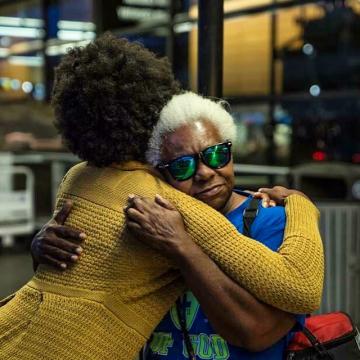
Tucker and her biological mother, Deborah, embrace at Seattle-Tacoma International Airport after their first visit in August 2015. (Courtesy of Bryan Tucker)
Teresa Burt says her daughter's search "has made her stronger. After doing it, she can help others and is helping others with their searches."
Tucker's experiences inform "The Adopted Life," a web series she created with filmmaker and husband Bryan Tucker. She talks one-on-one with other young adoptees, and utilizes her expertise at Amara, where she has started a mentorship program.
‘Everyone is looking to figure out who they are. ... I think for adopted kids, and particularly transracially adoptee kids, they have to continually work through their stories.’
– Brett Bowton-Meade, adoptive father
One adoptee is Maggie, the 9-year-old middle child of Amy and Brett Bowton-Meade. The couple, who are white, also have two biological daughters - one older and one younger than Maggie.
Maggie has been wrestling with questions about belonging and about her biological mother. Tucker, her mentor, has encouraged keeping a record.
"I've been writing down things in my journal," Maggie said, noting that the book also contains pictures. "And if I meet her someday, I'll bring it with me."
At work, Tucker tries to smooth the adoption process for the children, including pushing ideas such as convincing more black families to adopt.
"I'm not saying that adoption should be only same-race. But I am saying that it's like walking a tightrope," she said.
Since finding her biological parents, Tucker says she feels "less confused. But the fact that my birth mother couldn't raise me is sad. And it's not going to change."
After finding her birth parents, Angela Tucker decided to mentor other adoptees. (Arzouma Kompaoré/VOA)
Credits
Reporter: Claire Morin-Gibourg
Camera: Arzouma Kompaoré
Script And Web Editor: Carol Guensburg
Video Editor: Betty Ayoub
Video Narration: Hayde Adams FitzPatrick
Copy Editor: Sharon Shahid
Web Design and Development: Edin Beslagic and Stephen Mekosh
Comments